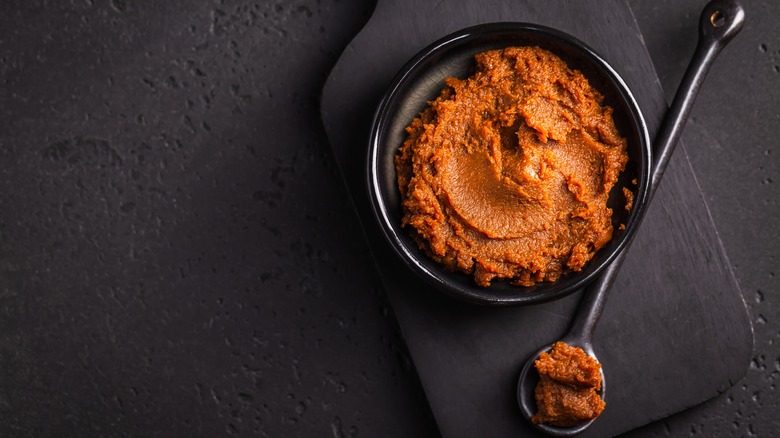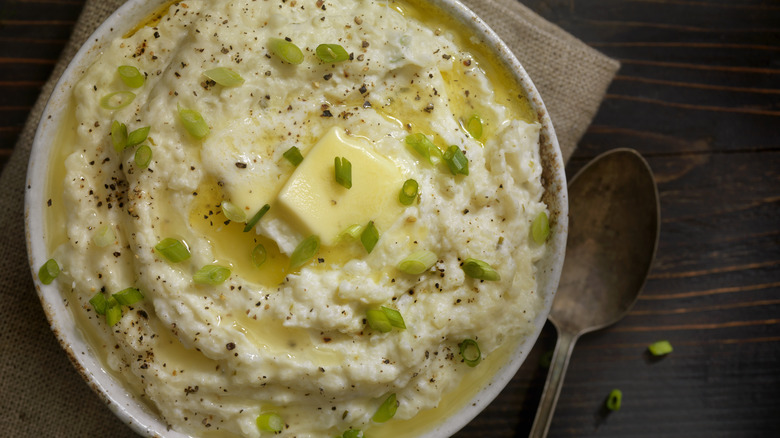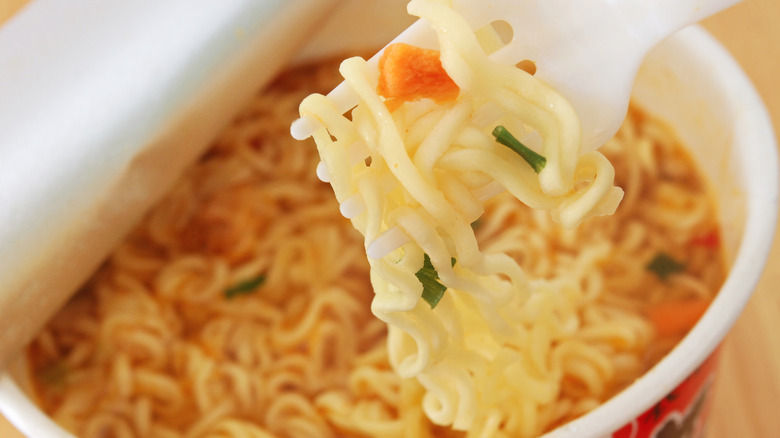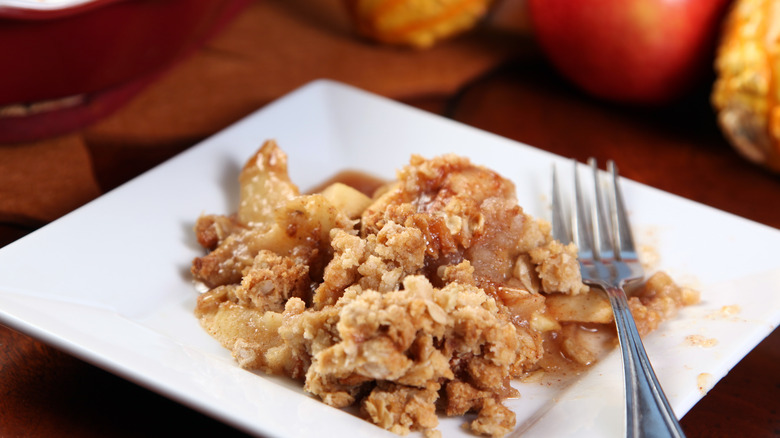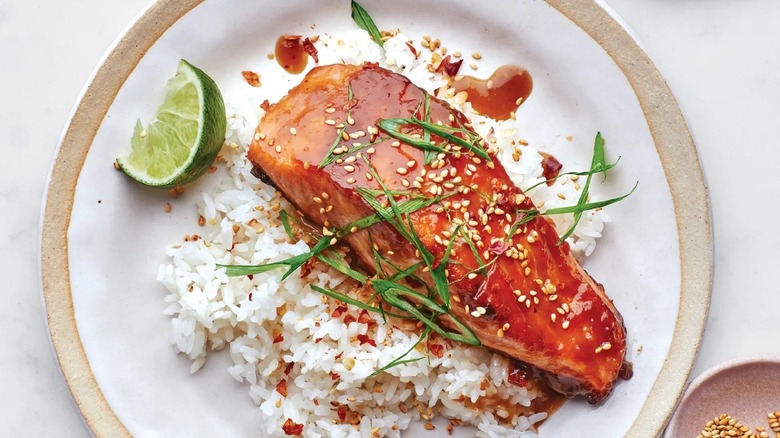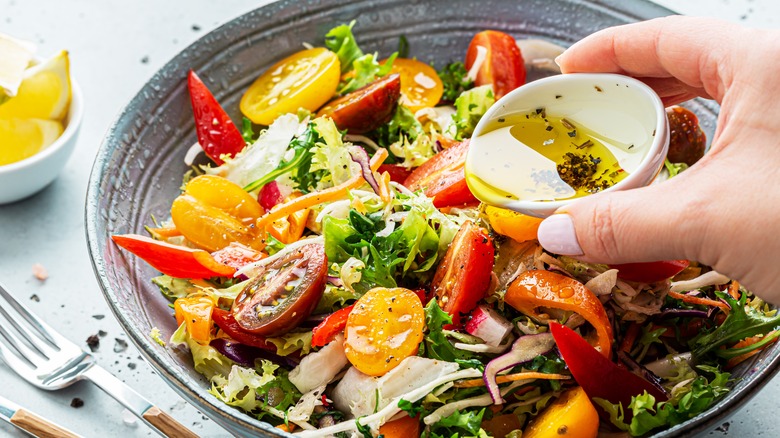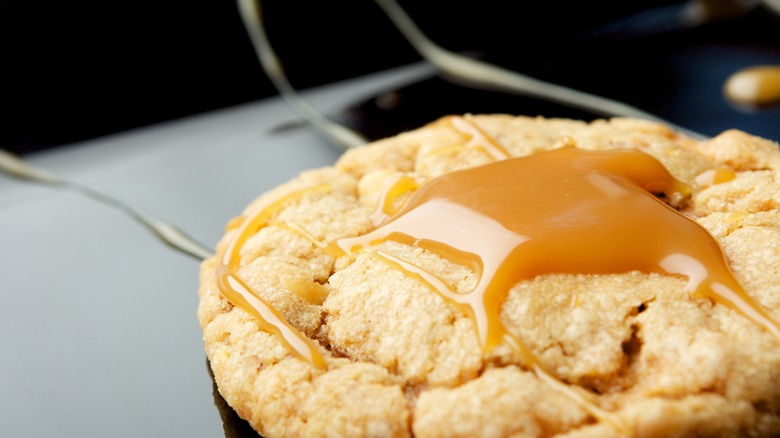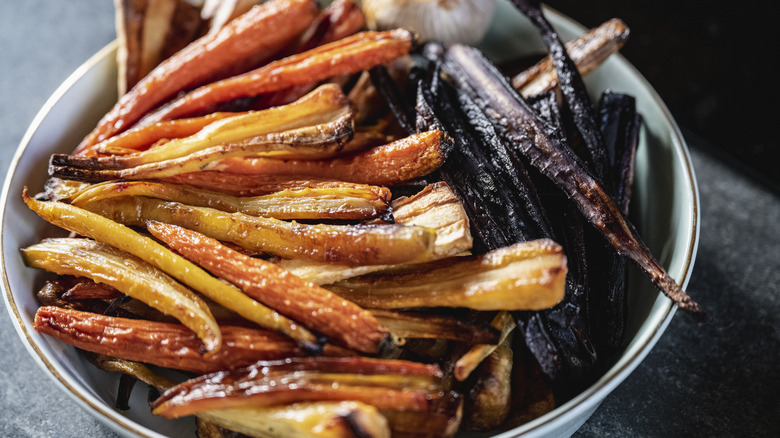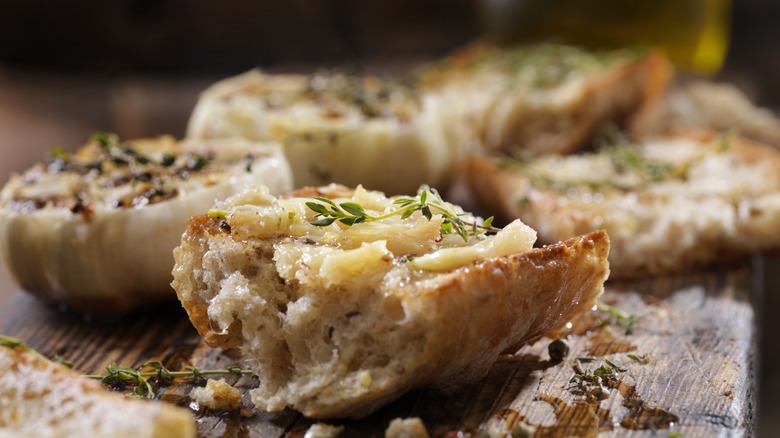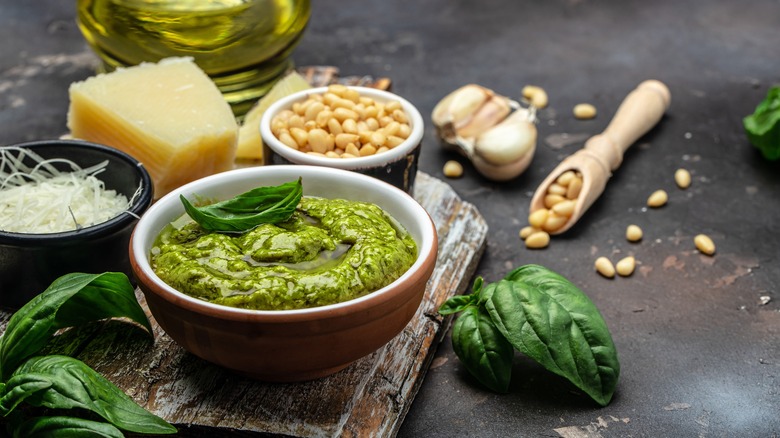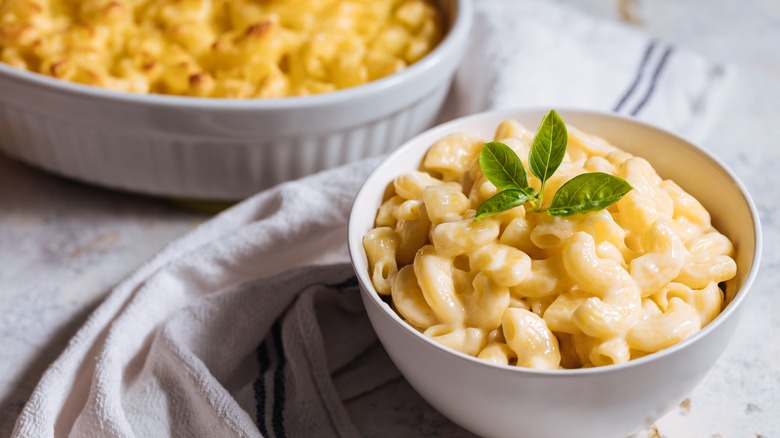18 Creative Ways To Use Miso Paste
No ingredient in the kitchen is as utilitarian as miso paste. This spreadable paste is derived from a mixture of cooked soybeans, salt, and a culture called koji. The mixture is allowed to ferment on a base of rice, barley, or soybeans until it's ready to be made into a thick, peanut butter-like paste. The length of this period will determine the final color and flavor of the miso. In most grocery stores or ethnic markets, you'll find three primary types of miso: white (shiro), yellow (shinshu), and red (aka). The darker the color, the more funky and pungent the paste is. But, as a whole, the flavor of miso is described as being both salty and umami, with tangy, fishy, and earthy undertones.
Many people's understanding of miso and its use in the kitchen caps out at a bowl of miso soup from their local takeout spot. But we're here to highlight this powerful ingredient and how it can be used to elevate sauces, dressings, and even desserts.
Pair miso with potatoes for a great side dish
For the most part, you shouldn't mess with a classic dish. Mashed potatoes are one of those sides that have been perfectly engineered to be smooth, creamy, and especially flavorful when topped with a pat of butter. You should try adding miso to your mashed potatoes to complement the butter and the cream (or milk). The otherwise bland potatoes crave the depth that miso can provide, which makes this a perfect match. You should use a lighter miso, either yellow or white, for this recipe, as the red miso will skew the color and come off a bit too strong for your taters.
Potato salad is another side dish that can benefit from a scoop of miso. You can add miso to your potato salad by mixing it in with the dressing ingredients. Start with white miso because it will satisfy the need for salt without giving off too many funky flavors. Mayo-based dressings aren't the only ones that can benefit from miso either; you can also add a dollop of the paste to your vinaigrette-based potato salad dressing.
Make a unique cocktail
Mixologists and cocktail gurus are always whipping up different concoctions and flavors to try. One ingredient that has become increasingly popular on the cocktail scene is miso.
White miso adds an unexpected flavor boost to cocktails and can also make them smell a bit more appealing, too. If you want to experiment with this savory spread, you'll want to use only the white variety rather than the more strongly flavored red or yellow miso. In addition, you'll want to avoid swirling the paste right into your cocktail glass or shaker and serving it since the paste has a gritty texture that can ruin the mouthfeel. Running the mixture through a strainer can help, but it's not the only way to marry miso and booze together. Instead, use the miso in a shrub or infuse it in a simple syrup.
Give your baked goods a leg up
A favorite way to use miso paste is to add it as a unique edge to baked goods. Any baker knows that finding an opportunity to add subtle saltiness to a dessert is important because it not only tones down the overly sweet flavor but also amplifies other ingredients like citrus and spice. While many bakers will automatically grab a container of salt, miso provides a more flavorful opportunity to experiment with. It has a uniquely organic flavor, along with complex umami — something you won't get from salt alone.
One recipe where miso is an asset is in your chocolate cake. Dark chocolate cakes often have a complex, dirt-like flavor. The miso mellows out these cocoa notes and makes for a more well-rounded dessert. You can add the miso to your cake recipe or a batch of your favorite cookies by creaming the miso with the butter and the sugar. Taste as you go, and note that you will have to cut the amount of other salty ingredients to accommodate for the miso.
Use miso as a substitute for instant ramen packets
Instant ramen will always be a (not so) guilty pleasure. Slurping the noodles while tuning into one of a favorite show on Netflix will always make for the perfect evening. But the main qualm with ramen is not the wavy noodles but the seasoning packets.
Let's face it: Ramen flavor packets won't offer the same flavor nuances as a traditional broth that has been simmering on the stove for most of the day. If you want to replicate some of the same umami notes but without the overwhelming saltiness, grab a container of miso instead. The paste has earthy elements that will ground your broth and impart a ton of flavor. Yellow and white miso are perfect for an inexperienced miso eater, while red miso packs a punch with a heavier and more umami-forward profile. Stir a few tablespoons in and taste from there.
Use it for extra color in apple crisp
Apple crisp is a simple and satisfying way to use up the leftover fruit from your trip to the orchard. But, if you're only adding sugar and a little bit of cinnamon for spice, you may be missing out on all of the creative opportunities to dress up your apple crisp.
Miso is the secret ingredient for golden brown apple crisp. You'll want to mix mild white miso right into the streusel topping by melting it with the butter. The savory umami notes will help calm some of the oppressiveness of the brown sugar and also enhance the spices that you add to it. Plus, the earthiness of the miso will help mellow out the sweet, floral apples and make for a well-rounded dessert.
Balance out your bloody mary
If there's an alcoholic beverage that knows savory and umami all too well, it's a bloody mary. This tomato-forward cocktail pairs vodka with some unconventional (at least, unconventional in the cocktail world) flavoring agents like Worcestershire sauce, pickles, and hot sauce. Miso is among friends in this cocktail, and it is bound to impart a bold flavor on your bloody mary.
You can mix your miso paste directly into the bloody mary mix to ensure it's well-distributed throughout the beverage. This is really a choose-your-own-adventure in regard to what type of miso you should add to the mix. If you haven't worked with miso before, a white variety will be a good start. But if you like the pungent flavor of red miso, go right ahead and stir it in.
Impart salty and umami flavors on your veggie burgers
It is difficult to replicate the same meaty flavor in a veggie burger as in a beef patty. But miso is the ingredient that can get you there.
It is the umami touch your veggie burgers need and yearn for. What's great about this fermented paste is that you can pair it with whatever ingredients you add to your burger patty, including eggplants, grains, or beans. Besides adding an umami boost to your patty, the sticky miso also helps keep the patty together as it cooks.
You should match the miso based on the ingredients and makeup of your patty. If you're working with other umami-rich ingredients, like tomato or mushrooms, it's recommended to go for the funky flavor of the red miso. But if you're using lighter, more vegetal flavor from peas and corn, go with a light-colored paste.
Add an unexpected flavor to your peanut butter and jelly
It's not just PB&J; it's PB&J&M (miso). Although it might seem like a blatant defacement of the classic American sandwich we know and love, miso is the umami boost that will make a better peanut butter and jelly sandwich.
The key to imparting umami to this sandwich correctly is to combine your peanut butter with the miso paste rather than just adding a separate layer of miso between your bread. Aim for unsalted peanut butter to avoid shifting the flavor balance too much into savory territory. It may be better to use natural peanut butter rather than one made with hydrogenated oils (like Jif) so that the fat can easily mix with the miso and keep the mixture suspended. White and yellow miso are the preferred varieties here, as red miso is far too funky.
Use miso in your fish marinade
Miso and fish go hand in hand. This miso salmon recipe is made with a brown sugar, soy sauce, and brown (red) miso marinade. It's flavorful and the perfect complement to the buttery, flaky fish.
Similarly, Jacques Pépin uses miso to flavor fish. He makes a similar marinade for his salmon but also adds a bit of maple syrup to contrast the umami and savoriness of the other ingredients. The famed chef also recommends reserving some of that glaze for after the fish is finished cooking. He also uses miso for a hot chili garlic marinade, which he pairs with a flaky cod filet. Pépin roasts his cod in the oven until it's just slightly undercooked before topping it with the flavorful sauce.
Schmear miso butter on your corn on the cob
There's no feeling quite like biting into a whole, fresh corn cob on a hot summer day. The feeling of the kernel juice flying all over your face and the frustration of trying to keep your pat of butter on the fork are just some of the experiential perks of this summertime favorite. But if you want a truly transformational eating experience, consider adding miso to the equation.
This hack will give corn on the cob an upgrade and impart a piquant flavor without requiring you to reach for the salt shaker. For this recipe, you'll need to whip up a compound butter — which is just simply mixing butter and your flavorful add-in together, chilling the butter until solid, and then using it for whatever your heart desires. Besides schmearing miso butter on corn, you can also add a pat to the top of your steak or to the pan before you cook up your eggs in the morning.
Use it as a plant-based substitute for sardines
Sardines are an admittedly acquired taste. The fresh-from-the-sea flavor intermingled with tinny and metallic undertones makes for a niche ingredient — and one that plant-based eaters can't indulge in. If you have a sauce that calls for these fish, or if you're whipping up a from-scratch Caesar dressing, reach for the miso paste instead.
You can easily swap sardines for miso paste. Just scoop a couple of teaspoons of miso paste from the container and add it to your dish, tasting it as you go to find your desired level of miso flavor. Granted, the miso won't replace the same texture as the fish, but you could use a few jackfruit bulbs if you want to get as close as you can to the real thing.
Mix it into your favorite pasta sauce
A good sauce, regardless of whether if its a marinara, butter sauce, or cream sauce, has the perfect balance of acidic, savory, and umami notes. While you can add a bit extra salt, there are better ways to check off at least two of these flavor boxes: miso. Adding miso paste to your next pasta sauce will take it to the next level and help complement the ingredients already in it. For example, the paste will provide an extra layer of complexity to already flavorful elements like mushrooms, chicken, and fish.
There's no exact time when you have to add the miso to your sauce. If you're working with a butter sauce, you might add the paste in with the fat to help build a base of flavors. But for a marinara sauce, you'll want to add it towards the end to help round out the sharpness and acidity of the tomatoes.
Swirl it into your salad dressing
Grocery store salad dressing will suffice in a pinch, but it's shorter than you think to go the extra mile and make your own. You can add virtually any seasoning to match your salad ingredients, including sliced shallots, garlic, and sesame. But if you haven't tried adding miso to your salad dressing yet, you're missing out.
The miso will act as a natural thickener for your dressing and give it an almost creamy quality. Plus, the umami flavor will provide a plant-based boost to your greens and veggies. Pair miso with other bright, punchy ingredients like ginger, spicy hot sauce, and rice vinegar. While it's naturally a great addition to Asian-inspired salads, there's no reason you couldn't add a scoop to your favorite balsamic dressing, either.
Make an unbelievable salty caramel with miso
Miso caramel is what dreams are made of. Like other salty-sweet matchups, a miso salted caramel is perfectly balanced because the sweet brings attention to the savory and vice versa. Plus, you can use it on almost anything, from a drizzle on your ice cream to the base of your caramel apples in the fall.
You'll want to start this recipe by cooking your caramel as normal and allowing the butter and the sugar to meld. Then, you can mix in a diluted miso paste to impart the salty flavor. Stir it for a few extra minutes before pulling the caramel from the heat. You'll get the most unadulterated miso flavor possible, which pairs well with the toffee notes of the sweet caramel.
Use it as a dressing for your roasted veggies
Plain roasted veggies leave much to be desired. The cooking process transforms the crunchy veggies into limp ones, and besides the slightly sweet flavor of some root vegetables like sweet potatoes and carrots, there's not much there. That's why you have to pair your roasted veggies with a bright glaze to perk them up a bit.
Our recipe for miso-braised parsnips can easily be adapted for roasting or for other root veggies — or even Brussels sprouts. Not only does the sauce have the earthy flavor from the miso, but it also has a hint of spice from the similarly-textured gochujang. If you're roasting your veggies, add a schmear of this delicious sauce after you've pulled your tray from the oven.
Add an extra umami layer to your garlic bread
There's so much to love about a comforting side like garlic bread. But if you want to add extra flavor and complexity to this classic carb, grab the container of miso from your fridge.
This viral garlic bread hack is relatively simple. It combines roasted shallots and garlic, red pepper flakes, butter, and miso together to make a flavorful, slightly sweet purée. This is spread in between the slices of the bread before its covered with cheese and baked to perfection. What's to love about this sauce? It's perfectly balanced. The caramelized shallots and garlic offer a sweet refuge from the heat of the red pepper flakes. Meanwhile, the miso covers all things savory and makes this dish a perfect complement to pasta or cozy winter soup.
Swirl it into your pesto
This isn't your Nonna's pesto anymore. Miso paste is the game-changing ingredient that you need to consider adding to your next batch of this summery condiment. Pesto already had umami from the cheese, but adding even a little bit of miso will ensure that this flavor note is maxed out.
Miso can be admittedly overwhelming, especially when you're working with basil's herbaceous notes. So, it's always best to work with this paste in incremental doses and always add less than you think you'll need. Begin with a light miso, either a white or a yellow, so that you don't blow the entire dish away with saltiness. Paired with a good olive oil, this is a match that can't be beat.
Make an extra delicious batch of mac and cheese
Homestyle macaroni and cheese is a dish that will always draw folks back for seconds. The perfect dish has slightly al dente noodles and cheese that gives you the perfect ooey, gooey texture. But, you need to focus some of your attention on flavor, too — and that includes adding complex elements like miso.
Miso goes well with mac and cheese because it latches on to the saltiness of the cheese. If you go with a gouda or another creamy cheese, its nuttiness will also marry well with the similar flavors in the miso. Start by adding a small scoop of mildly flavored paste to your cheese sauce, taste it, and add more as needed. The paste also plays well with others, like crumbled bacon, broccoli, and potentially pulled pork.
